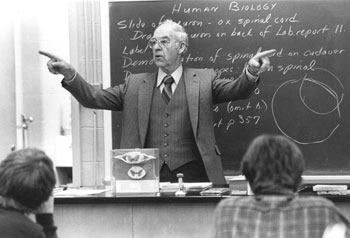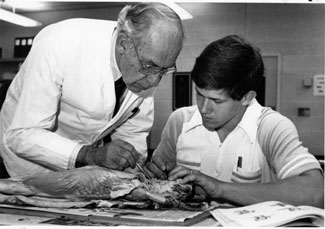Dr. Daniel Suter, Model Teacher
Smart and Humble, Rigorous and Loving
Such was the message that emerged, comment after comment, page after page, when Dr. Daniel Suter’s daughter, Janice Showalter, assembled the notes she received from his former students after her father’s death on December 24, 2006.
“As a member of the last class to have him as an advisor, I feel blessed and thankful,” wrote R. Todd Weaver ’87, a dentist who is president of the Mennonite Medical Association.
“Dan was the father figure who believed in me, next to my own father, of course. He was so supportive and respectful, unlike the professors I was to meet in professional school. He taught us to be respectful of ourselves and others…how to take initiative, responsibility, and how to problem-solve.
‘He taught us about the wonders and the mystery of God’
“He gave us feedback and taught us how to be creative,” continued Weaver. “But, above all, he taught us about the wonders and the mystery of God. He was the first scientist who demonstrated to me/us not only how to act as a scientist, but believe as a Christian.”
Suter joined the science department at EMU in 1948 and eventually became head of the biology department and pre-med advisor. He retired in 1985.
 During his tenure, EMU established a remarkable acceptance rate for its pre-med students: more than 85 percent
were and are admitted into medical, dental and veterinary schools, well above the
national average of 40 to 50 percent.
During his tenure, EMU established a remarkable acceptance rate for its pre-med students: more than 85 percent
were and are admitted into medical, dental and veterinary schools, well above the
national average of 40 to 50 percent.
“At many medical colleges, Dr. Suter’s word of recommendation was considered enough for admission,” says Stan Godshall ’65, a family practitioner who earned his medical degree at the University of Pennsylvania. Suter provided recommendations for about 300 students during his 36 years of teaching.
“Dr. Suter quietly launched us all,” says Kenton J. Zehr ’83, cardiac surgeon at, successively, the Mayo Clinic and University of Pittsburgh Medical Center.
‘The kind of Christian I’d like to be…"
Wrote Joyce Hostetler, a former administrator at the Mennonite Medical Association: “He was, in the very best sense, the kind of Christian I’d like to be…gentle, honest, clear, compassionate, and alive.”
Dr. Suter teaching anatomy…Janelle Aby ’86, a Stanford University pediatrician, was among the last to be taught by Suter. In an anatomy class where a cadaver was to be dissected, “Dr. Suter made sure we remembered this was a person who had dignity, family, and friends – he insisted that we treat the cadaver with the utmost respect,”she said.
“As I later entered medical school and compared notes with many others, many of whom came from very elite colleges, I realized how rare an opportunity we had been given, and how important Dr. Suter’s preamble was in setting the appropriate attitude in medical work,” added Aby. “What a difference it makes to see patients as amazing creations of a loving God!”
Aby also credited Suter and his fellow faculty members with establishing a reputation whereby “my EMUdegree laid out something of a red carpet for me on the interview trail.”
EMU Education Gives Graduates Distinct Advantages
“People seemed to recognize that this small college with its unique opportunities gave its graduates some distinct advantages, producing future physicians who were conscientious, well-rounded, and prepared for further education,”said Aby (pictured on page 4), a clinical assistant professor of pediatrics at Stanford.
Suter was the son of Eastern Mennonite’s first registrar, J. Early Suter. His father advocated that Eastern Mennonite not limit itself to being a Bible school, but also offer academic courses like English, algebra and Latin. This proposal was accepted when he and A.G Heishman agreed to teach these courses on the condition that their pay come out of any money remaining after the Bible teachers were paid.
So Suter grew up in the shadow of this school and graduated from it when it was a junior college. He earned his bachelors degree at Bridgewater College. Years later, as a “mature” student with a family to support, he earned a masters degree at Vanderbilt University and a PhD in neuroanatomy at the Medical College of Virginia. (At MCV he found himself in classes with two former students of his – Ron David ’60 and Duane Diller ’60 – whom he laughingly said he “struggled to stay ahead of.”)
In a campus chapel on the eve of his retirement in 1985, Suter credited his wife Grace for “supporting the family (eventually four children) by taking care of a small laying hen flock, milking the family cow, and laundering shirts for EMC fellows” while he was away in graduate school.
An Important Choice
Toward the end of his doctoral studies, Suter was offered a post at MCV. The offer was tempting: “time for research, a teaching load that small-college teachers dream about, teaching entirely in my area of interest, a unique opportunity to be a Christian witness in a non-Christian situation, and a salary nearly triple what I would get here.”
But he felt "God wanted me to be at EMC, "despite the frustrations of lack of educational resources, miniscule salaries that forced him to moonlight, and views sometimes expressed in the students’ Weather Vane that made him think, “I may as well be teaching in a non-Christian school.”
The First of Hundreds of Students
As a freshly minted teacher in the late 1940s, Suter said he “practiced” on his early students, naming six of them in his chapel talk. All became physicians, the first to emerge from Eastern Mennonite. The first six students today:
- In a part-time, post-retirement position, Paul T. Yoder is editor of the Milepost section of the Crossroads Magazine
- Ruth Peachey is a retired psychiatrist in Florence, Alabama
- John Paul Heatwole is a retired anesthesiologist in Waynesboro, VA
- David Kauffman Sr. is a retired family physician in Whitefish, Montana
- Abe Hostetter is a consulting psychiatrist in Charlottesville, VA
- James R. Brunk Sr. is a retired internist in Harrisonburg
As chair of the Nursing Education Committee in 1966, Suter helped plan and set up Eastern Mennonite’s nursing program . In the same era, he helped plan the science center that came to carry his name."The trustees gave the planning of the building and its furnishings almost entirely into the hands of the science faculty and its architects, "Suter said in his 1985 chapel, recalling that he moved the lab equipment from the basement of the old administration building to the new building in his GMC pick-up truck.
A Career that Spanned Generations
The satisfaction of seeing hundreds of students – often successive generations from the same family – ultimately" make a contribution to the spiritual and physical well-being of those they serve "trumped any misgivings and hardships Suter had along the way. “Very rarely did I have any doubt that here is where God wanted me to be.”
From the summer 2008 issue of Crossroads alumni magazine, which focuses on EMU’s science alumni, serving and leading the world over.


